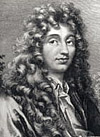Christiaan Huygens

Christiaan Huygens was born in The Hague, The Netherlands, 14 April 1629 as the second son of Constantijn and Susanna Huygens. His father, from a wealthy family, was a diplomat in service of the House of Orange.
In his younger years Christiaan did not go to school but was taught by teachers at his home. He very early showed to be a bright and talented pupil. The family was acquainted with Descartes who got impressed by the talents of the young boy and Descartes certainly influenced him both during his studies and later, in particular in the field of mathematics. In 1645 Christiaan went to the University of Leiden to study mathematics and law and between 1647 and 1649 he continued these studies at the newly established Orange College of Breda where his father just had become a curator. While he was studying law, it was quite clear that his major interests were in physics and mathematics. He wrote his first scientific publication in 1649, De iis quae liquido supernatant (On hydrostatics). He was appointed member of the Royal Society in 1663 and in 1666 he became one of the first members of the French Academy of Sciences.
After the invention of the telescope by another Dutchman, Hans Lippershey, an eyeglass maker, Galileo used for the first time the telescope for astronomical purposes making many new discoveries. Huygens, among many others, realised that with improvements in the optics new celestial phenomena were waiting for being discovered and so started himself, together with his brother Constantijn, to manufacture telescopes and to refine the techniques of making them. With time the two brothers became very skilled telescope makers. Christiaan also developed a theory of the telescope and soon formulated the law of refraction to derive the focal distances of lenses.
In 1655, using his own telescope, he discovered the largest Saturnian moon, later to be named Titan, and in 1659 he was the first to realise that the rings of Saturn are indeed rings.
In these days measurement of time was a real challenge and of great importance for navigation at sea. Huygens studied seriously the problems related to measurement of time and invented the pendulum clock which dramatically improved the accuracy of time measurements. In 1673 he published his work Horologium Oscillatorium, where he describes the theory and practical realisation of this invention.
Huygens was a truly multidisciplinary scientist and studied and published papers on a large variety of topics ranging from the wave theory of light, mathematics and mechanics to practical topics as optics design formulae and music, among many other things. One of his last works was the philosophical Cosmotheoros where he even speculates on life on other planets.
Christiaan Huygen lived his life as single and he had no children. He died back in The Hague in 1695. In his testament he donated his manuscripts and correspondence to the University of Leiden and some of his instruments and lenses can now be found at the Museum Boerhaave in Leiden.
